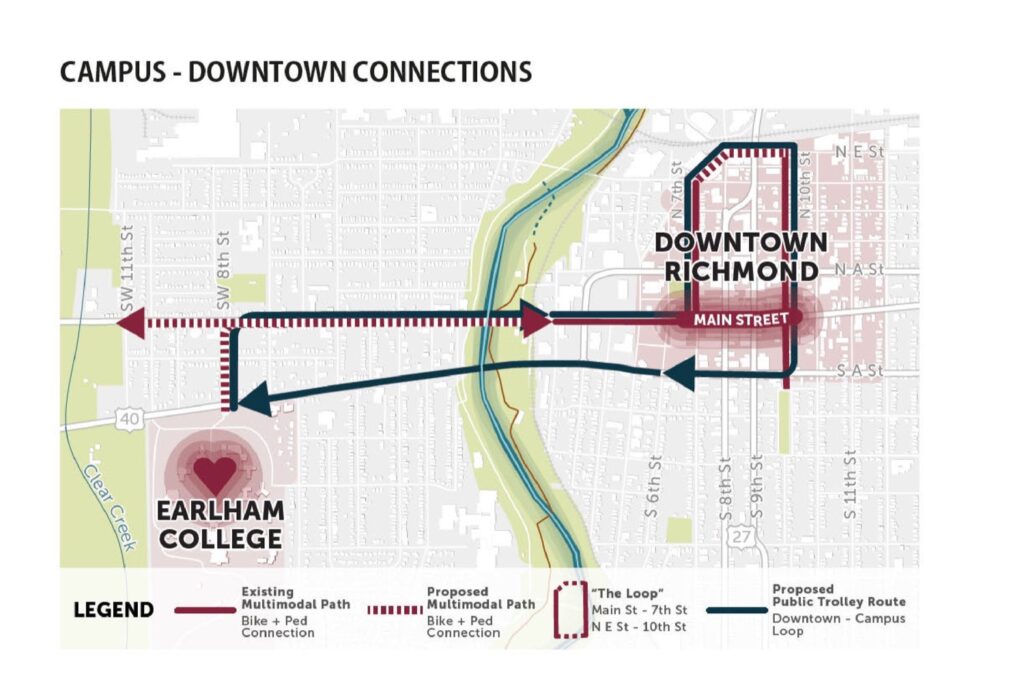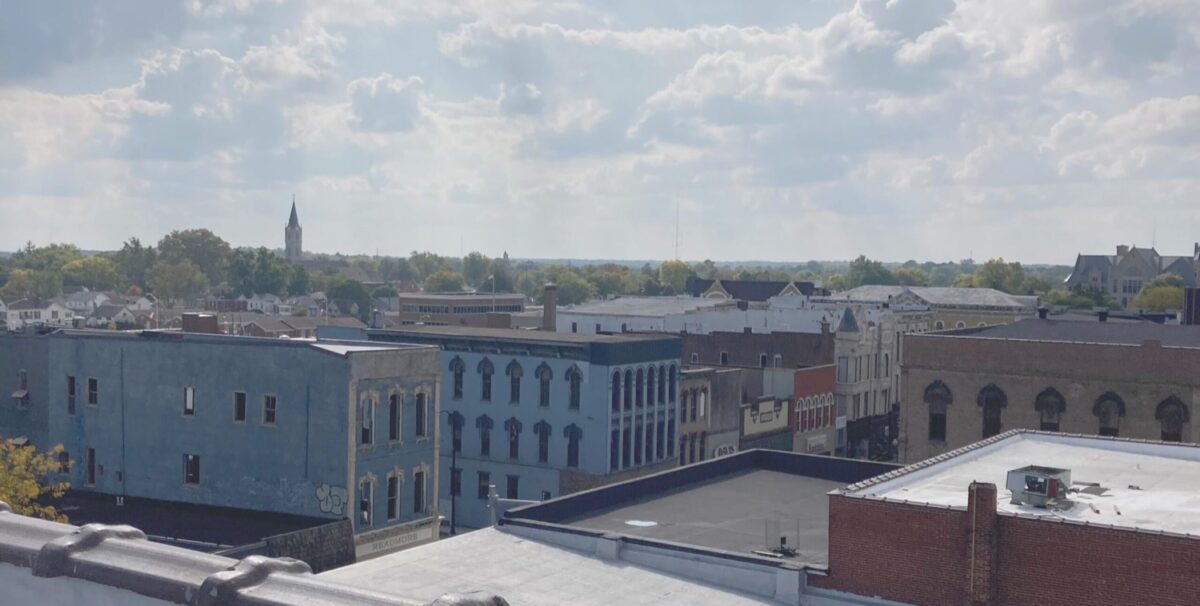With help from a new $25 million grant, $108 million in improvements are planned that aim to boost community pride and attract and retain workers and students in Wayne County.
Nearly 50 Earlham College employees and local leaders worked over about eight months on the Revitalize Richmond proposal that won Lilly Endowment Inc.’s support.
Earlham’s application successfully demonstrated the benefits of improving downtown Richmond and better connecting it with the westside campus.

Planning for much of the work — boosting housing, transit and outdoor recreation — is already under way.
Lilly’s grant will be spent within five years. It provides partial support to restore historic buildings for commercial and residential uses; develop a multimodal pathway to connect downtown and the campus; and enhance Whitewater Gorge Park.
Earlham College President Anne Houtman said because Richmond organizations and government officials have been thinking about these issues for at least a decade and secured $83 million in matching funds toward the work, Earlham had an edge in the application process.
Committee members couldn’t just dream about potential investments. The application had to focus on concrete projects that already are in process or have committed funding. According to multiple people familiar with the planning process, the meetings saw participants putting their personal and organizational agendas aside to consider what would be good for the broader community.
Richmond Mayor Dave Snow, who served on the central steering committee, said having the Richmond Rising Comprehensive Development Plan in place was crucial for winning Lilly funds.
Snow said work toward a Richmond renaissance in the last eight years is paying off as developers are making “record-level investments” after seeing the city’s opportunities and wanting to be part of its growth.
“I’m really happy to see such belief in that potential because that is turning into dollars,” Snow said.
Snow called the Lilly grant “25 million reasons to believe” and said the win is a testament to the city’s team and to Earlham staff who spearheaded the Lilly application and care very much about the community’s health and economic vitality.
Houtman said she didn’t want to win a grant to just fix something, but one that would also lead to more investment in Richmond benefiting both the college and the community.
During the application process, residents and college faculty, staff and students were asked what would make their Richmond experience more positive.
Houtman said employers including Earlham and Reid Health have faced challenges in recruiting workers to Richmond, particularly young workers, because they want to be in a more urban area with downtown housing and a vibrant business environment.
Earlham also has lost prospective students to other colleges because they said Richmond wasn’t exciting enough for them. And, for the students who do come, some feel isolated on campus if they don’t have a vehicle.
“This will help us recruit good people to come and stay in Richmond,” Houtman said.
Citing the campus’ 1847 founding by some of Richmond’s early settlers, she said if Earlham grows, the city grows, and vice versa.

When Houtman called him with the good news, Richmond Mayor-elect Ron Oler said, “I was practically jumping up and down for joy for what this means for our city.”
Oler said this “incredible investment” should remind residents that the rest of the state hasn’t forgotten Richmond and recognizes it as a great place to invest, raise a family and return to.
Key partners in the application process include City of Richmond, Economic Development Corp. of Wayne County, Earlham graduates and local residents Eric and Becky Dimick Eastman, who are founding a downtown Makerspace; Forward Wayne County, Main Street Richmond, Richmond Neighborhood Restoration, Richmond Parks and Recreation and Wayne County Foundation.
“The scope of the projects included in the Revitalize Richmond initiative would typically take decades to effectively secure funding for,” said EDC President Valerie Shaffer in a news release. “Now we can move confidently and quickly forward on key efforts that have been planned to secure a strong future for our community.”
The $83 million in matching funds includes previously planned public and private investments to build market-rate apartments at the site of the former Elder-Beerman building, along with a mix of other private investments and existing or committed grant opportunities.
“We also know that progress of this magnitude has the potential to attract additional interest and investment in our community for years to come,” Shaffer said. “The impact of this grant cannot be overstated.”
The foundation awarded a total of $145.8 million to six Indiana colleges and universities in Indiana through its College and Community Collaboration initiative.
Three awards went to liberal arts schools (Earlham, Taylor University in Upland and Wabash in Crawfordsville), while three went to larger state universities (Ball State in Muncie, Purdue in West Lafayette and Indiana State in Terre Haute).
Ball State received $35 million toward revitalizing The Village, a commercial district adjacent to campus. Plans include a performing arts center; owner-occupied residences; new market-rate apartments; a hotel; restaurants and other retail outlets; an innovation center connecting university academic programs with local entrepreneurs and business professionals; an events plaza; and an arts and culture trail.
Some of the other communities’ projects include supporting early childhood education and childcare; quality of life, especially for a growing Latino population; expanding a rideshare program; and trail, downtown and airport improvements.
Before the winners were chosen, all 35 eligible Indiana colleges and universities submitted planning proposals and received planning grants with a combined value of more than $9 million.
The Lilly family created the Indianapolis-based private foundation in 1937 through gifts of stock in their pharmaceutical business, Eli Lilly and Company. The endowment supports community development, education and religion.
What’s planned for Revitalize Richmond?
BUILD: Large-scale housing Initiatives and building renovation
- Strategic investments in renovation and rebuilding downtown
- Revitalizations of several buildings between 5th and 13th streets
- New and modern apartment complexes, including live/work spaces
- Renovation of significant historical buildings
- New entrepreneurial space through “Placement Loans Accelerating Companies and Entrepreneurs” (PLACE)
ACTIVATE
Business Development and Support
- Free/low-cost business coaching for local small business owners and entrepreneurs
- Identification/recruitment of established regional businesses
- Expanded shopping, recreation and creative-making options in downtown
Whitewater Gorge
- New riverwalk, zipline and rowing activities at Whitewater River Gorge Park
Makerspace
- Two local Earlham alumni, Eric and Becky Dimick Eastman, are opening a Makerspace downtown to support creativity
Beautification/Programming
- Downtown public art installations, greening of spaces, new wayfinding signs
- Events and programs to celebrate re-energized downtown and connect Earlham and Richmond communities.
CONNECT: Public transportation and multimodal paths
- New electric and ADA-accessible trolley will circulate between Earlham, downtown Richmond and Depot District
- Improvement in service and delivery of city’s public transit options
- New multimodal transit path connecting Earlham to downtown Richmond
Learn more at earlham.edu/revitalize-richmond
WWN’s Chris Hardie contributed to this story.
A version of this article appeared in the December 20 2023 print edition of the Western Wayne News.

